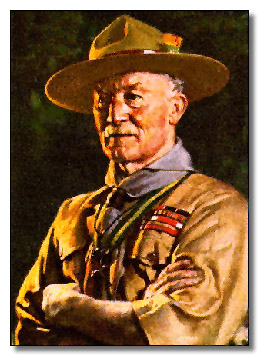


Robert Baden-Powell, the man who started the Scouting Movement, spent over thirty years as an officer in the British Army. It was while he was soldering that he began to develop a number of ideas about how soldiers - especially military scouts- should be trained. B.-P. (as we fondly call him) was a soldier before there was aircraft to spot enemy locations and strengths. In his time, if an army wanted to know what the enemy was doing, it had to send out military scouts to do a reconnaissance. B.-P. thought that such scouts would be more effective if they were self-reliant. To encourage his military scouts to develop this self-reliance, B.-P. organized them into small groups with their own leader. His ideas were published in an army booklet called Aids To Scouting.
Around the turn of the century, Baden-Powell received worldwide attention when he commanded a force of soldiers that defended the town of Mafeking in South Africa. For 217 days, Baden-Powell’s forces resisted the efforts of a larger Boer force to dislodge them. Needing to stretch his manpower, B.-P. organized a cadet corps of local boys to serve as messengers, first aiders, and lookouts, and to do other useful tasks so the soldiers could concentrate on defending the town. Finally, another British force arrived to lift the siege.
In 1904, B.-P. was asked to attend the annual inspection of the Boy’s Brigade. After the event, B.-P. told the Brigade’s founder, Sir William Smith, that he thought the Brigade would have a larger membership if its program were more varied and less based on the army’s military drill. He offered some suggestions , and Smith proposed that B.-P. write a book for boys similar to Aids to Scouting.
Four years passed before the book appeared. During that time, B.-P. did the necessary research, and talked to others involved with youth organizations. Before he began to write, he decided to test out his ideads. In 1907, he took twenty one boys between the ages of 11 and 16 to Brownsea Island off the southern coast of England. There, he organized them into patrols and taught them some basic self-reliance skills. During the week, they pitched tents, swam, cooked meals outdoors, and learned to track, and tie knots. In short, they “scouted”.
When it was first published, B.-P.’s book didn’t appear as a whole book. Instead, it came out in six parts. The first instalment of Scouting for Boys appeared on Wednesday, January 15, 1908. It was an immediate success, and boys (and girls, too) eagerly awaited every other Wednesday until the end of March 1908 for the new sections to arrive.
When B.-P. wrote Scouting for Boys, he didn’t intend to start another organization, and he really didn’t. Boys did, because Scout patrols and Scout troops began to spring up entirely on their own all over the country. By 1909, there were already about 100,000 Scouts.
In 1910, the King of England (Edward V11) asked Baden Powell to resign from the army and devote himself full time to the Scouting Movement.
Scouting has continued to grow, and now there are more than 28 million members in 216 countries and territories around the globe. It’s not known exactly which troop was the first in Canada. When B.-P. visited our country in August 1910, he persuaded the Governor General, Earl Grey, to become Chief Scout of Canada.
On June 12,1914, the Boy Scouts of Canada were incorporated by an Act of Parliament.
B.P. had an exciting childhood, and some of his exploits and adventures as a soldier and
spy were absolutely thrilling. If you want to read more about B.-P.’s life, check your school or public library for B.-P.’s Life in Pictures , or Baden Powell : The Man Who Lived Twice, by Mary Drewery. Another book to look at is Baden Powell’s Scouting for Boys. Ask your Patrol Counsellor if the troop owns any of these books.
Lord Robert Stephenson Smyth Baden-Powell of Gilwell was born on February 22, 1857, in London, England, and died on January 8, 1941, in Kenya. Every year, the week in February that contains B.-P.’s birth date is called Scout-Guide Week. Your patrol or troop will probably want to do something special during that week as a way of remembering this man whose imagination provided the spark for the worldwide brotherhood of Scouting.
B.-P. The Artist
If Baden Powell had been a Scout rather than the founder of Scouting, his first Challenge
Badge probably would have been Artist. Originally, Baden-Powell was a military officer; one time he used his drawing interest and ability to fool the enemy. He disguised himself as a butterfly collector and went close to the enemy’s fortifications. Then he made drawings of “butterflies”. Actually, hidden inside the butterflies’ markings were the locations of the enemy’s weapons.
When enemy soldiers challenged Baden-Powell, all they could see in his drawings were the butterflies. By looking at the two pictures, you can see how he hid the information he needed in the butterflies’ wings.
If you want to know more about other exciting episodes in Baden-Powell’s life, read B.-P.’s Life in Pictures. Your Patrol Counsellor can tell you how to get a copy. Perhaps your Counsellor has the book Scouting for Boys, by Baden-Powell. It includes more of his sketches.